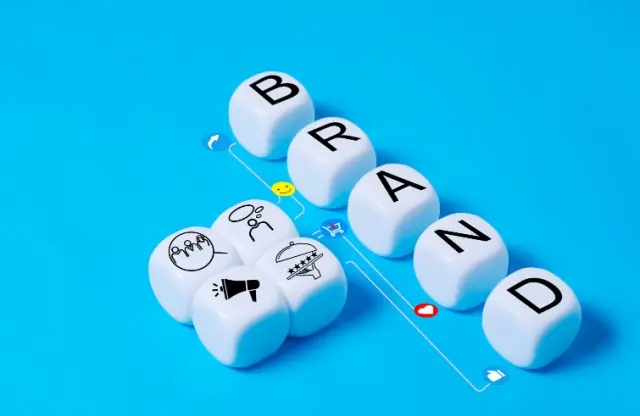
Building a strong brand image is crucial for any business. It’s what sets you apart in the consumers’ minds. A positive one can lead to better word of mouth, effective customer service, and a stronger connection with your target customers. When your brand has a strong reputation, your product or service becomes more memorable. Your target audience will recognize and trust you. This trust can turn casual buyers into loyal customers.
In this article, we’ll explore everything you need to know about brand image. We’ll delve into what it is and the theory behind it. We’ll also discuss what gives rise to a it and the importance of having a positive one. You’ll learn about the different types and components. We’ll also cover how to build and measure a strong one. Finally, we’ll compare brand image with brand identity, brand awareness, and brand personality, and provide examples of companies with a positive brand image.

What is Brand Image?
Brand image is the perception of your brand in the minds of consumers. It’s how they see and feel about your product or service.
Having a positive brand image is crucial for any marketing strategy. It helps build trust and loyalty among your target market. When potential customers view your brand positively, they are more likely to choose your product or service over others. A strong one influences their buying decisions and makes your brand memorable. It’s important to consistently work on it to ensure it aligns with your values and appeals to your audience. Remember, your brand image isn’t just about logos or slogans; it’s about the overall perception of your brand. It’s how your target market feels and thinks about what you offer.

What is Brand Image Theory?
Brand image theory explains how consumers form perceptions about a brand based on their interactions and experiences with it. This theory suggests that brand image is the collective impression that consumers have about a product or service. It is influenced by the brand’s marketing strategies, communications, and customer interactions.
A brand image is crucial because it shapes how potential customers think of your brand. A strong one includes a positive image and aligns with your brand values and brand voice. This alignment ensures that your target market views your brand favorably. In turn, this can lead to increased loyalty and preference over competitors.
For instance, when a company communicates its value proposition and maintains a consistent brand voice, it helps create a strong and positive brand image. This makes the brand more appealing to its target market and can differentiate it in a crowded marketplace. The perception of your brand is built through consistent and positive customer experiences. This could be through marketing campaigns, product quality, or customer service interactions.

What gives rise to Brand Image?
Perception comes from many factors that shape how people see a brand. This view is influenced by things like customer service, product quality, and marketing.
Customer service, product quality, and marketing strategies are all key to shaping a brand’s image. Good customer service creates a lasting impression, building loyalty as satisfied customers return and recommend the brand. High-quality products or services that meet or exceed expectations also boost reputation, leading to repeat business. Effective marketing, including advertising, social media, and influencer partnerships, helps promote and establish the brand. For example, Nike uses celebrity endorsements and big campaigns to highlight athletic excellence and innovation.
Reputation develops over time through consistent delivery of value and adherence to brand values. It’s not only about one interaction but all the experiences customers have with the brand. This ongoing positive experience helps shape a strong, favorable image in their minds.
Building a positive one needs a well-rounded approach. This includes great customer service, high-quality products or services, smart marketing, and a clear understanding of the brand’s values and target audience.

The Importance of Having a Positive Brand Image
Having a positive brand image is crucial for any business. It helps create trust, recognition, and loyalty among customers. It influences customer perceptions and can lead to long-term success. Here are some key benefits:
1. Makes a Strong First Impression
When potential customers encounter a well-crafted brand, it creates a strong first impression. When people first encounter your brand, they quickly form opinions. A positive one can grab their attention and make them eager to learn more about your product or service. This initial impression is critical in attracting new customers and retaining their interest.
2. Builds Awareness
Brand recognition is a key part of a positive brand image. When people recognize your brand, it stays in their minds. Effective marketing strategies, such as advertising and social media campaigns, help build this recognition. Over time, as more people become aware of your brand, it becomes easier to reach your target audience and stand out from competitors.
3. Adds Value to Your Brand
A positive perception contributes to brand equity, which is the value your brand adds to your products or services. Customers often associate a strong brand name with higher quality and reliability. This perceived value can justify higher prices and improve sales. It also makes it easier to introduce new products under the same brand name, as customers are more likely to trust them.
4. Increases Conversions
A strong brand image can boost conversion rates. When customers have a positive view of your brand, they are more likely to make a purchase. This trust and familiarity make the decision-making process easier for them. Effective marketing that emphasizes your brand can lead to higher sales and increased customer loyalty.
5. Establishes Credibility
Credibility is vital in gaining and maintaining customer trust. A consistent and positive brand image shows professionalism and reliability. Customers are more likely to trust brands that consistently deliver on their promises. This trust can lead to long-term customer loyalty and positive word-of-mouth recommendations, which are invaluable for business growth.
6. Demonstrates Professionalism
A well-crafted brand image reflects professionalism. It shows that your business is serious and committed to quality. Consistent branding across all channels, from your website to customer service, reinforces this professionalism. It helps customers feel confident in choosing your product or service over others.
Building and maintaining a positive one is essential for attracting and retaining customers. It enhances brand recognition, adds value, increases conversions, establishes credibility, and demonstrates professionalism. By focusing on these aspects, businesses can achieve long-term success and build strong relationships with their customers.

Different Types of Brand Image
Understanding the various types of brand image is essential for businesses to effectively position themselves and stand out in the marketplace. Here are the key types:
Positive Brand Image
A positive brand image means customers think highly of the brand. It also builds brand recognition and customer loyalty, allowing them to see that that the product or service consistently meets expectations. This boosts the brand’s reputation and increases brand equity.
Negative Brand Image
A negative brand image happens when customers have bad perceptions of a brand. This can come from poor product quality or bad customer service. It can harm the brand’s reputation, reduce brand equity, and make it hard to attract new customers and keep existing ones.
Neutral Brand Image
A neutral brand image means the brand doesn’t evoke strong feelings, either positive or negative. This usually happens when a brand is not very visible or lacks distinct features. While it doesn’t hurt the brand, it also doesn’t help build strong brand recognition or customer loyalty.
Corporate Brand Image
This type refers to how people see the company as a whole, beyond its products or services. This image is shaped by the company’s values and actions. A strong one can build customer trust and loyalty, helping the company stand apart from the competition.
Product Brand Image
This type explains how customers view a specific product within the brand. It can be different for each product offered by the same brand. A strong product brand image can drive sales and customer preference for that specific product, helping overall brand equity.
Personal Brand Image
This type depicts how people view an individual. It is often linked to entrepreneurs or celebrities. This type can strongly influence customer perceptions and build a connection with the target audience. It is especially important for personal brands where the person’s reputation impacts the brand’s success.
In summary, these types of brand images help businesses understand how they are seen and where they can improve. Building a positive brand image is key to strong brand recognition, customer loyalty, and standing out in the market.

Components of a Brand’s Image
Understanding the components of a brand’s image helps businesses build a strong brand that resonates with customers. Here are the key components:
Visual Elements
Visual elements include the logo, colors, and design. These elements create a recognizable and consistent brand identity. A strong visual presence in social media posts and other materials enhances brand recognition and helps establish a strong brand image and visual identity.
Brand Values
Brand values are the core principles and ethics that a brand stands for. These values shape how customers perceive the brand, based on their experiences. When a brand consistently demonstrates its values, it builds trust and loyalty among its target audience.
Customer Experience
Customer experience encompasses every interaction a customer has with a brand. This includes visiting the website, customer service interactions, and using the product or service. A positive and seamless customer experience reinforces a strong brand image and fosters customer loyalty.
Marketing and Advertising
Effective marketing and advertising strategies help shape and communicate the brand image. Consistent messaging across all channels, including social media posts, reinforces brand positioning and keeps the brand top-of-mind for customers. Well-executed marketing can differentiate a brand from its competitors and build a lasting impression.
Product Quality
The quality of the product or service is crucial in forming a strong brand image. High-quality offerings that meet or exceed customer expectations build trust and reliability. Consistently delivering quality products enhances brand equity and strengthens the brand’s reputation.
Emotional Connection
Creating an emotional connection with the audience is vital. This connection is often built through storytelling, brand values, and customer experiences. Brands that evoke positive emotions are more likely to build a loyal customer base and stand out from the competition.
A strong brand image is built through a combination of visual elements, brand values, positive customer experiences, effective marketing, high product quality, and emotional connections. These components work together to create a cohesive and appealing brand that resonates with the target audience.

How to Build a Strong Brand Image
Building a strong brand image helps your brand stand out. Follow these simple steps to create and maintain a strong one:
1. Define Your Brand Identity
First, decide what your brand stands for. Identify your mission, vision, and values. These should reflect what you want customers to think and feel about your brand. This foundation helps you align with the right audience and position yourself effectively .
2. Understand Your Audience
Know your target audience well. Conduct market research to understand their needs and preferences. This information helps you tailor your brand message and create a brand image that resonates with them. It also helps in making effective marketing strategies.
3. Create Consistent Visuals and Messages
Consistency is key. Develop brand guidelines that include your logo, color scheme, and tone of voice. Make sure all your marketing materials, from social media posts to ads, follow these guidelines. Consistency helps in brand recognition and shows reliability.
4. Deliver Quality Products and Services
High-quality products or services are essential. Always meet or exceed customer expectations. This builds trust and loyalty. Ensure that your offerings match your brand’s promises and values, reinforcing a positive brand image.
5. Engage with Your Audience
Interact with your audience on social media and other channels. Respond to their comments and feedback promptly and genuinely. Positive interactions help build a strong connection with your brand. This engagement also helps you track and manage your brand image based on real-time feedback.
6. Monitor and Adjust Your Brand Image
Regularly check how your brand is performing. Use surveys, focus groups, and social media tools to get feedback. This helps you understand how your brand is seen and find areas to improve. Adjust your strategies to keep your brand’s reputation and image strong and relevant.
By following these steps, you can build a strong brand image that stands out, earns customer loyalty, and helps your business grow.

How to measure Brand Image
Measuring brand image helps you understand how people see your brand. Here are simple steps to do it:
1. Conduct Brand Perception Surveys
Surveys ask customers what they think about your brand. Questions can cover values, quality, and trust. This helps you see how people view your existing brand and where you can improve.
2. Analyze Social Media Mentions
Check social media platforms for comments about your brand. Use tools to track what people are saying. This gives you real-time insights into your brand’s reputation and shows how your brand’s image changes over time.
3. Use Focus Groups and Interviews
Talk directly to customers through focus groups and interviews. These methods give detailed feedback and reveal deeper feelings about your brand. They help you understand the nuances of your brand image and find specific areas to improve.
4. Conduct Neuromarketing Studies
Neuromarketing measures unconscious reactions to your brand. Tests like Implicit Association Tests (IAT) show deep, hidden feelings customers have. This helps you understand the true impact of your brand image and how it influences customer behavior.
5. Check Online Reviews and Ratings
Regularly check reviews and ratings on sites like Google, Yelp, and Amazon. Customer reviews highlight what people like and dislike about your brand. Analyzing these reviews helps you see common themes and fix issues to improve your brand’s image.
By using these methods, you can get a clear picture of your brand’s image and learn how to make it better.
Brand Image vs. Brand Awareness
Brand image is what people think about a brand based on their experiences, while brand awareness is how well people know the brand’s name and products. A strong brand image can lead to good customer relationships. This is the first step because people need to know about the brand before they can form an opinion.
Brand Image vs Brand Identity
Brand identity is how a company wants people to see it. It includes the logo, colors, and the way it communicates. Think of it as the company’s outfit. Brand image, however, is how customers actually see the brand. This view comes from their experiences with the brand. While the company controls brand identity, brand image is shaped by customers.
Brand Image vs. Brand Positioning
Brand positioning is how a brand stands out in the market. It shows what makes the brand unique and better than competitors. Brand image is the result of brand positioning and other marketing efforts. It’s how consumers see the brand based on these efforts. Good brand positioning helps create a positive one by clearly showing the brand’s strengths.
Brand Image vs. Brand Personality
Brand personality is like the brand’s character traits, such as being friendly or reliable. This personality is shown through the brand’s style and behavior. Brand image is broader and includes personality, reputation, and customer experiences. While brand personality helps shape brand image, it also includes things like customer service and product quality.
Examples of Companies with a Positive Brand Image
International Companies
Coca-Cola
Coca-Cola is known worldwide for its refreshing drinks. Its consistent branding and famous red logo make it instantly recognizable. Coca-Cola’s marketing focuses on happiness and togetherness, which helps maintain a positive public perception.
Apple
Apple is famous for its innovative products like the iPhone and MacBook. Its sleek design and user-friendly interfaces set it apart. Apple has a strong reputation that is built on quality, innovation, and style.
Nike
Nike is a top sports brand known for its “Just Do It” slogan. Its products are associated with athletic excellence and high performance. Nike’s use of celebrity endorsements and impactful marketing campaigns strengthens its reputation.
Indian Companies
Tata Group
Tata Group is known for its diverse range of products and services, from cars to steel. It has a reputation for reliability and trust. Tata’s commitment to quality and ethical business practices helps maintain its positive reputation.
Infosys
Infosys is a leading IT services company. It is known for innovation and excellent customer service. Infosys has a strong reputation due to its focus on technology and quality solutions.
Amul
Amul is famous for its dairy products, especially butter. Its witty and relatable advertising campaigns make it a household name. Amul’s commitment to quality and value strengthens its positive public perception.

Build and Improve your Brand Image with Synapse
Building a strong brand image is essential for any business. A positive one sets you apart in consumers’ minds, creating trust and loyalty. It also makes your product or service more memorable and appealing. Synapse, one of India’s top branding and business communication agencies, can help you achieve this. Our team of expert designers and project managers stay updated on all aspects of branding. We’ve worked with many prominent companies on their branding and marketing campaigns.
Check out our portfolio under the Showcase section on our website. Visit the Services page to learn about all the services we provide. Fill out the Contact Form on our website, WhatsApp us directly, call us at 1800 121 5955 (India), or email us at contact@synapse.co.







